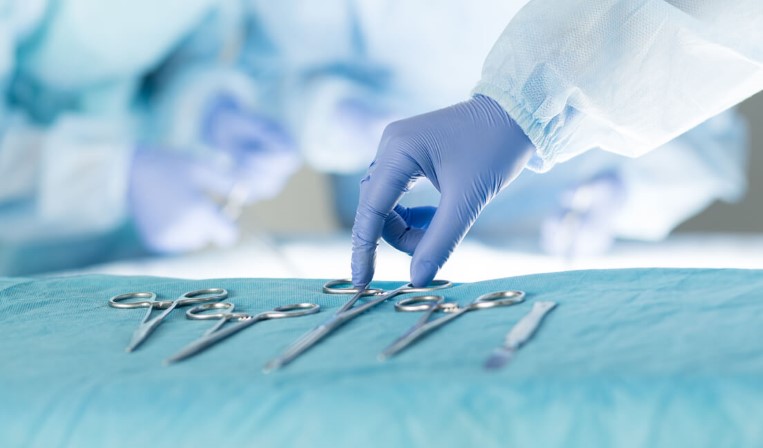The new standard, AAMI ST108, was published in August 2023, providing updated water quality requirements for sterile processing. > Learn More
In order to educate and provide guidance to healthcare facility personnel, the Association for the Advancement of Medical Instrumentation (AAMI) publishes a comprehensive Technical Information Report (TIR) called TIR34 – Water for the reprocessing of medical devices. This article will review the definition of water quality, the importance in sterile processing, adverse affects of poor water quality, and how the AAMI TIR 34 guidelines help ensure adequate water quality.

Water Quality Defined
Water, which can exist as a solid, liquid, or vapor, consists of one atom of oxygen and two atoms of hydrogen bonded together by their shared electrons. In terms of water purity, anything that is not an H+ or OH- ion is considered a contaminant or impurity.
The Environmental Protection Agency (EPA) identifies contaminants to regulate in drinking water to protect public health.1 The Agency sets regulatory limits for the amounts of certain contaminants in water provided by public water systems. Local public water systems treat water to these standards to make it potable (safe to drink). However, despite this treatment, water can become re-contaminated with chemicals and microorganisms as it is distributed through the municipality’s piping infrastructure. This contamination can be problematic for many applications that use this potable water. Sterile Processing in hospitals is one such application.
Water Quality is Important in Sterile Processing
Water quality is an important consideration in all stages of medical device reprocessing. The primary objective of medical device reprocessing is to ensure that a device is safe for patient use and does not cause an adverse event in the patient.2 3
It is important that personnel who reprocess medical devices (or use them in procedures) understand how the quality of the facility’s water can have an impact on the reprocessing equipment, as well as the devices and instruments themselves. It is also important that personnel recognize that the quality of water should be regularly monitored to ensure that the control measures in place are working properly.
Water Treatment
Water treatment includes a collection of water purification devices and associated piping, pumps, valves, and gauges that together produce purified water of a specified quality and deliver it to the point of use. Water purity is an indication of the extent to which impurities (e.g., dissolved organic and inorganic solids and microbial contaminants, ionic, and chemical) have been removed.
AAMI TIR34: 2014/(R)2017
This living document is intended to provide guidelines on the quality of water that should be used in each stage of medical device reprocessing for each category of medical device. It also includes annexes that provide technical information to water maintenance personnel (i.e., personnel such as Facilities Engineering/Management who are involved in water treatment and distribution in the facility) to guide them in configuring and monitoring water treatment systems.
More specifically, AAMI TIR34: 2014/(R)2017 includes the following:
- Covers the quality of the water used to clean, rinse, disinfect, and sterilize medical devices.
- Defines water types on the basis of hardness, pH, microorganism levels, endotoxin levels, and other characteristics. The following topics are covered:
- Importance of water quality and effective water treatment
- Categories of water quality for medical device reprocessing
- Selection of water quality
- Water treatment systems
- Monitoring of water quality
- Strategies for microorganism control
- Personnel considerations
- Continuous quality improvement
- Troubleshooting water quality issues
- Provides definitions of terms and a bibliography
- Annexes contain technical details pertaining to water treatment and monitoring for the benefit of water maintenance personnel
Categories of Water Quality for Medical Device Reprocessing
- Utility Water - water that comes from the tap that may require further treatment
- Used for flushing, washing, rinsing
- Critical Water - water that is extensively treated to ensure microorganisms, inorganic, and organic materials are removed
- Used for the final rinse or steam generation
Categories and Recommended Levels of Water Quality for Medical Device Reprocessing
| Types of Water Water Use |
Utility Water¹ Flushing/Washing/Rinsing |
Critical Water Final Rinse²/Steam |
||
|---|---|---|---|---|
| Specifications | Units | |||
| Hardness | mg/L | < 150³ | < 1 | |
| Conductivity (mg/L = ppm) |
µS/cm | < 500 | < 10 | |
| pH⁴ | 6-9 | 5-7 | ||
| Chlorides | mg/L | < 250 | < 1 | |
| Bacteria | cfu/mL | n/a | < 10⁵ | < 10 |
| Endotoxin | EU/mL | n/a | < 20⁵ | < 10 |
Note 1 - This is the quality of water that might come from the tap but might need some form of treatment to achieve these specification.
Note 2 - If this is the final rinse prior to sterilization of a critical device.
Note 3 - If hardness is greater than 150 mg/L, a water softener is recommended unless used for washing and the cleaning chemistry is capable of handling higher levels of hardness.
Note 4 - For boiler-treated steam, most boilers are treated to maintain a pH of 7.5 or 8.5. Any treatment of water that goes into boilers should be in accordance with the sterilizer and boiler manufactures’ written IFU.
Note 5 - After high-level disinfection.
References:
Author: Jeffrey Holland, BSCEM, MBA, Director of Health Science, Evoqua Water Technologies
¹ United States Environmental Protection Agency - https://www.epa.gov/dwstandardsregulations; 2018
² AAMI TIR34: 2014/®2017 - Water for the reprocessing of medical devices
³ ANSI/AAMI ST79:2017 - Comprehensive guide to steam sterilization and sterility assurance in health care facilities
NOTE: This primer is intended to provide a general overview of the importance of water quality for sterile processing, as well as the AAMI TIR34: 2014/(R)2017 guidelines. It is not intended act as a substitute for healthcare personnel reading the full AAMI TIR34 document, additional industry, guidelines, or medical device manufacturers’ Instructions for Use (IFU).
